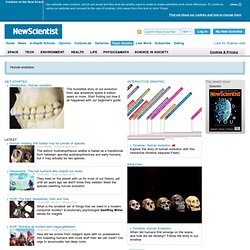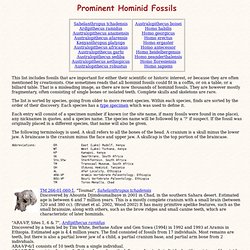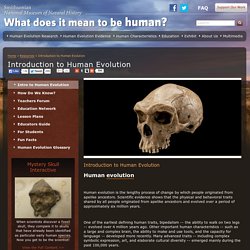

Cave Of Forgotten Dreams.
Human Evolution. Cookies on the New Scientist website close Our website uses cookies, which are small text files that are widely used in order to make websites work more effectively.

To continue using our website and consent to the use of cookies, click away from this box or click 'Close' Find out about our cookies and how to change them Log in Your login is case sensitive. Human evolution. Science & Nature - The evolution of man. Museo de la Evolución Humana. Publicaciones. Museo de la Evolución Humana. Publicado 13 diciembre, 2013 Por Pedro Pozas Personas no Humanas El 25 de junio de 2008, tras dos años de intenso debate en los medios de comunicación desde que presenté el Proyecto Gran Simio (PGS) en el Congreso de los Diputados, se aprobó después de una larga exposición de motivos, … [...]

Publicado 7 diciembre, 2013 Por Juan Luis Arsuaga Ferreras Diversos aspectos sobre el #ADNAtapuerca del Fémur XIII de la Sima de los Huesos Con motivo de la noticia publicada en Nature sobre el ADN encontrado en la Sima de los Huesos de Atapuerca, varios medios de comunicación me solicitaron mi opinión por escrito. Recojo en este post las columnas publicadas en El País, … [...] Publicado 23 octubre, 2013 Por Emiliano Bruner Los nombres escritos en las rocas Parece que cada nuevo hallazgo en paleoantropología “revolucione” los conocimientos en este sector de la antropología evolutiva.
Publicado 22 octubre, 2013 Por María Martinón DMANISI NOS TRAE DE CRÁNEO. Un Homo heidelbergensis y una Australophitecus afarensis, de la mano en Internet. Early Hominin Evolution: Analysis of Early Hominids. Bipedal locomotion may have been an adaptation to living in a mixed woodland and grassland environment.

It has been suggested that bipedalism was selected for because it made it easier to see long distances when moving over areas covered with tall grasses. This would have been a useful advantage in scavenging for food and watching for big cats and other predators in open environments. An upright posture also potentially helps to dissipate excess body heat and reduces the absorption of heat from the sun because less skin has a direct exposure to ultra violet radiation during the hottest times of the day. There is evidence suggesting that bipedal animals usually can walk greater distances because less energy is expended with their longer strides. This would be useful for scavenging for food throughout vast areas. The fossil record of early hominins is being added to by new important discoveries almost every year. Becoming Human. Fossil Hominids: the evidence for human evolution.
Prominent Hominid Fossils. This list includes fossils that are important for either their scientific or historic interest, or because they are often mentioned by creationists.

One sometimes reads that all hominid fossils could fit in a coffin, or on a table, or a billiard table. That is a misleading image, as there are now thousands of hominid fossils. They are however mostly fragmentary, often consisting of single bones or isolated teeth. Complete skulls and skeletons are rare. The list is sorted by species, going from older to more recent species. Each entry will consist of a specimen number if known (or the site name, if many fossils were found in one place), any nicknames in quotes, and a species name.
The following terminology is used. TM 266-01-060-1, "Toumai", Sahelanthropus tchadensis Discovered by Ahounta Djimdoumalbaye in 2001 in Chad, in the southern Sahara desert. KP 29281, Australopithecus anamensis Discovered by Peter Nzube in 1994 at Kanapoi in Kenya (Leakey et al. 1995). Stw 53, Homo habilis? Introduction to Human Evolution. Human evolution Human evolution is the lengthy process of change by which people originated from apelike ancestors.

Scientific evidence shows that the physical and behavioral traits shared by all people originated from apelike ancestors and evolved over a period of approximately six million years. One of the earliest defining human traits, bipedalism -- the ability to walk on two legs -- evolved over 4 million years ago. Other important human characteristics -- such as a large and complex brain, the ability to make and use tools, and the capacity for language -- developed more recently. Many advanced traits -- including complex symbolic expression, art, and elaborate cultural diversity -- emerged mainly during the past 100,000 years. Humans are primates. Most scientists currently recognize some 15 to 20 different species of early humans. Early humans first migrated out of Africa into Asia probably between 2 million and 1.8 million years ago.
Human Fossils. From skeletons to teeth, early human fossils have been found of more than 6,000 individuals.

With the rapid pace of new discoveries every year, this impressive sample means that even though some early human species are only represented by one or a few fossils, others are represented by thousands of fossils. From them, we can understand things like: how well adapted an early human species was for walking uprighthow well adapted an early human species was for living in hot, tropical habitats or cold, temperate environmentsthe difference between male and female body size, which correlates to aspects of social behaviorhow quickly or slowly children of early human species grew up.
While people used to think that there was a single line of human species, with one evolving after the other in an inevitable march towards modern humans, we now know this is not the case. Like most other mammals, we are part of a large and diverse family tree. Recursos educativos.